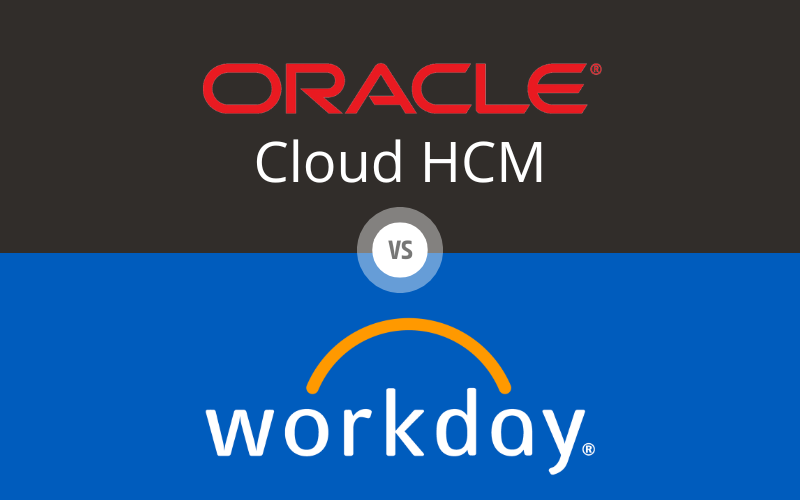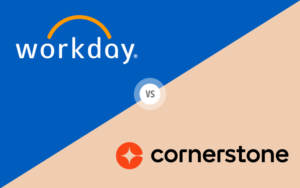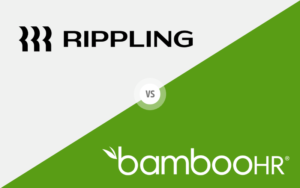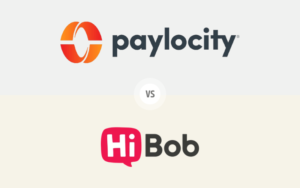When choosing between Oracle Cloud HCM vs Workday, organizations must carefully evaluate which human capital management system best meets their specific needs. Both platforms offer powerful tools for managing HR functions, but they cater to different types of businesses. This comprehensive comparison covers key aspects such as user interface and experience, core HR functions, payroll management, and more, to help you make an informed decision for your organization’s HCM needs.
Table of Contents
User Interface and User Experience
When comparing Oracle Cloud HCM vs Workday, the user interface (UI) and user experience (UX) are critical elements to consider. Both platforms aim to simplify HR processes through their design philosophies, but they offer distinct experiences and interfaces tailored to different organizational needs.

Oracle Cloud HCM User Interface and User Experience
Oracle Cloud HCM presents a modern interface that emphasizes accessibility and a comprehensive feature set. The design is aimed at facilitating complex HR tasks with an intuitive layout that, while feature-rich, may require a learning period for new users to navigate effectively.
Key Features of Oracle Cloud HCM UI/UX:
- Customization: Oracle allows extensive customization of its dashboard, enabling HR teams to configure the layout to better fit their workflows, which enhances user engagement and productivity.
- Complexity for Comprehensive Use: The platform’s design supports a wide array of HR functions, ideal for large organizations that need detailed control over their HR operations.
- Visual Analytics: Incorporates advanced visual analytics tools directly into the interface, aiding in more insightful decision-making and reporting.
Workday User Interface and User Experience
Workday offers a streamlined UI that prioritizes ease of use and minimalistic design, making it particularly appealing for organizations that value straightforward, efficient interactions over complexity.
Key Features of Workday UI/UX:
- User-Friendly Design: Workday’s interface is renowned for its clean, intuitive layout that minimizes the learning curve and allows users to perform tasks with fewer clicks.
- Engaging Visuals: Uses a visually appealing design with clear, accessible menus and engaging graphics that improve user satisfaction and interaction.
- Adaptive Learning: Features like embedded learning and help tools assist users in quickly adapting to the system, significantly reducing the need for extensive training.
Comparison and Conclusion
The comparison between Oracle Cloud HCM and Workday reveals fundamental differences in their approach to UI and UX, reflecting their distinct target audiences and operational philosophies. Oracle Cloud HCM’s interface, while offering deep customization options and a broad set of tools, might initially overwhelm new users but ultimately delivers a powerful, tailored experience for complex organizations. Its ability to handle multifaceted HR tasks makes it a solid choice for larger enterprises that require detailed reporting and analytics capabilities embedded directly into the HR workflow.
Conversely, Workday’s simpler, cleaner interface appeals to organizations that seek quick user adoption and high usability across all levels of the workforce. Its focus on reducing the number of interactions to complete tasks ensures that users spend less time navigating the system and more time using it effectively, which can be particularly beneficial in fast-paced environments.
In sum, the choice between Oracle Cloud HCM and Workday will largely depend on the organization’s scale, the complexity of HR operations, and the premium placed on user engagement and operational efficiency. Oracle Cloud HCM is likely the better option for large organizations looking for a highly customizable and feature-rich system, while Workday may be the ideal choice for companies prioritizing simplicity, speed, and user friendliness in their daily HR activities. This decision will ultimately influence the effectiveness of the HR department’s role within the organization, impacting everything from employee satisfaction to operational productivity.
Core HR Functions
Evaluating core HR functions is essential when comparing Oracle Cloud HCM vs Workday, as these functions form the backbone of any comprehensive human capital management system. Both platforms offer a wide array of features, but they cater to different needs and preferences based on their system capabilities and specialization.

Oracle Cloud HCM Core HR Functions
Oracle Cloud HCM is designed to provide a robust and flexible core HR platform that supports a global workforce. It excels in delivering a wide range of HR functionalities that cater to the diverse needs of large enterprises operating across multiple countries.
Key Features of Oracle Cloud HCM Core HR Functions:
- Global Compliance and Localization: Oracle Cloud HCM provides extensive support for global operations, including compliance with local employment laws and regulations, which is crucial for multinational companies.
- Comprehensive Employee Lifecycle Management: From recruitment to retirement, Oracle offers tools that manage every stage of the employee lifecycle, integrating these processes into a cohesive system.
- Advanced Workforce Analytics: Oracle’s powerful analytics capabilities allow HR teams to gain deep insights into workforce trends and make data-driven decisions to optimize HR strategies and processes.
Workday Core HR Functions
Workday focuses on delivering an intuitive and unified core HR experience that is easy to use and accessible to organizations of all sizes. It is particularly noted for its user-friendly interface and seamless integration capabilities.
Key Features of Workday Core HR Functions:
- Unified HR and Talent Management: Workday combines core HR functions with talent management in a single system, facilitating a more integrated approach to managing employee journeys.
- Employee Self-Service: Empowers employees by allowing them to manage their personal information, benefits, and other HR-related tasks directly, which enhances engagement and reduces administrative workload.
- Agile Organizational Management: Workday provides flexible tools to help organizations adapt to changes quickly, including reorganizations and team realignments, without the hassle of complex system configurations.
Comparison and Conclusion
In the Oracle Cloud HCM vs Workday comparison for core HR functions, the decision largely hinges on the specific requirements and scale of an organization. Oracle Cloud HCM’s suite is ideal for large, global companies that need a comprehensive, customizable system capable of handling complex, multi-country HR operations with advanced analytics and compliance features. This makes it suitable for organizations looking for depth and breadth in their HR system.
On the other hand, Workday offers a more streamlined and integrated experience, which may be more appealing to mid-sized to large organizations that value simplicity, agility, and the seamless integration of HR and talent management functions. Its user-friendly design and self-service capabilities ensure that both HR professionals and employees can maximize their interaction with the system efficiently.
Ultimately, organizations must assess whether they need a robust, extensive platform like Oracle Cloud HCM or a more streamlined, integrated solution like Workday to manage their core HR functions effectively. This choice will impact not only the operational efficiency of the HR department but also the overall employee experience within the company.
Payroll Management
Payroll management is a critical component of any human capital management system. A comparison of Oracle Cloud HCM vs Workday in terms of payroll functionalities can reveal significant differences in how each platform caters to the payroll needs of diverse organizations.

Oracle Cloud HCM Payroll Management
Oracle Cloud HCM provides a comprehensive payroll management system designed to handle complex and varied payroll requirements, especially suitable for large, multinational corporations with diverse and geographically dispersed employee bases.
Key Features of Oracle Cloud HCM Payroll Management:
- Global Support: Oracle Cloud HCM supports payroll operations in over 200 countries, offering localized solutions that adhere to specific regional compliance and regulatory requirements, making it ideal for global enterprises.
- Flexibility and Customization: The platform allows for extensive customization to meet the unique payroll needs of each organization, including varying pay structures, benefits, and other compensation elements.
- Integrated Financial Management: Oracle Cloud HCM payroll is tightly integrated with financial management systems, ensuring accurate and timely financial reporting and analytics.
Workday Payroll Management
Workday provides an efficient and user-friendly payroll management solution that is highly integrated with its core HR suite. It is particularly known for its configurability and ease of use, appealing to organizations that prioritize streamlined operations and user satisfaction.
Key Features of Workday Payroll Management:
- Configurable Payroll Processing: Workday offers a highly configurable payroll processing system that can adapt to the specific needs of the organization without extensive custom programming.
- Employee Self-Service: Workday enhances transparency and accessibility by allowing employees to access their pay slips and tax documents directly through the platform, fostering a higher level of employee engagement and self-management.
- Real-Time Reporting: The platform provides real-time payroll analytics and reporting capabilities, enabling HR and payroll teams to make more informed decisions quickly and accurately.
Comparison and Conclusion
In the comparison of Oracle Cloud HCM vs Workday for payroll management, each platform offers distinctive strengths that cater to different organizational needs. Oracle Cloud HCM’s robust, comprehensive payroll features are well-suited for large, complex organizations that require detailed customization and operate on a global scale. Its ability to handle diverse regulatory environments and integrate with financial systems makes it a powerful tool for multinational corporations.
Conversely, Workday’s payroll system excels in configurability and ease of use, making it ideal for organizations that seek a straightforward, efficient payroll solution tightly integrated with HR functions. Its real-time reporting and employee self-service capabilities are particularly beneficial for dynamic organizations looking to empower their workforce and streamline payroll processes.
Organizations must consider their specific payroll management needs, whether they require the robust, scalable capabilities of Oracle Cloud HCM or the streamlined, user-centric approach of Workday. This decision will significantly influence the efficiency and effectiveness of payroll operations and overall employee satisfaction.
Time and Attendance Tracking
Time and attendance tracking is a vital aspect of workforce management, directly impacting payroll accuracy, employee compliance, and overall operational efficiency. In this comparison of Oracle Cloud HCM vs Workday, we explore how each software handles time and attendance tracking, catering to different organizational requirements.

Oracle Cloud HCM Time and Attendance Tracking
Oracle Cloud HCM offers a robust time and attendance tracking system that integrates seamlessly with its broader HCM suite. This integration provides comprehensive management capabilities, particularly beneficial for large organizations with complex scheduling needs.
Key Features of Oracle Cloud HCM Time and Attendance Tracking:
- Comprehensive Integration: Oracle’s time and attendance solutions are fully integrated with its payroll and HR modules, ensuring that all data remains consistent and accurate across the board.
- Global Capabilities: Designed to support multiple time zones and regulatory requirements, Oracle is well-suited for multinational companies that need to manage a diverse, global workforce.
- Advanced Scheduling: Features sophisticated scheduling tools that help manage shift patterns, overtime, and compliance with labor laws, making it ideal for industries with complex workforce management needs.
Workday Time and Attendance Tracking
Workday provides a streamlined and user-friendly time and attendance tracking module that emphasizes ease of use and efficiency. It is designed to integrate flawlessly with the entire Workday suite, offering a cohesive experience for all users.
Key Features of Workday Time and Attendance Tracking:
- User-Friendly Interface: The system is known for its intuitive design, which simplifies the logging and management of time records, reducing the likelihood of errors and enhancing user engagement.
- Real-Time Updates: Workday allows for real-time tracking of employee hours, which facilitates immediate adjustments and provides up-to-date data for payroll processing.
- Mobile Compatibility: With a strong focus on mobile accessibility, Workday enables employees to log time and attendance remotely, which is especially useful for a mobile or remote workforce.
Comparison and Conclusion
When comparing Oracle Cloud HCM vs Workday for time and attendance tracking, the choice largely depends on the specific needs of the organization. Oracle Cloud HCM is particularly strong in environments that require robust, integrated solutions capable of managing complex global schedules and compliance requirements. Its extensive features support detailed management of diverse and large-scale workforce operations.
On the other hand, Workday offers a more straightforward approach that focuses on usability and integration. Its real-time updates and mobile compatibility make it suitable for companies that value simplicity and flexibility, particularly those with a significant number of remote workers or those needing to manage attendance on the go.
Organizations looking to choose between Oracle Cloud HCM and Workday for time and attendance tracking should consider the scale of their operations, the complexity of their workforce management needs, and the level of integration required with other HR functions. The decision will impact not only the efficiency of time and attendance management but also broader areas such as payroll accuracy and employee compliance.
Benefits Administration
Benefits administration is a critical function of human capital management systems, impacting employee satisfaction and retention directly. This comparison of Oracle Cloud HCM vs Workday will focus on how each platform manages benefits administration, offering unique capabilities that cater to different organizational needs.

Oracle Cloud HCM Benefits Administration
Oracle Cloud HCM provides a comprehensive benefits administration module designed to support complex and varied benefits programs, especially suitable for large, multinational corporations with diverse employee needs.
Key Features of Oracle Cloud HCM Benefits Administration:
- Global Support and Compliance: Oracle Cloud HCM facilitates management of benefits programs across different countries, adhering to local regulations and customs, which is crucial for global enterprises.
- Flexible Benefits Configuration: Offers extensive customization options for defining and managing a wide range of benefits packages, from health insurance to retirement plans, catering to diverse workforce requirements.
- Integrated Analytics: Utilizes advanced analytics to help HR teams understand benefits utilization and cost effectiveness, aiding in better decision-making and policy adjustments.
Workday Benefits Administration
Workday provides an intuitive and integrated benefits administration solution that simplifies the management of employee benefits through a user-friendly interface and seamless integration with other HR functions.
Key Features of Workday Benefits Administration:
- Employee-Centric Design: Workday’s platform is built around an employee-centric approach, making it easy for employees to enroll in and manage their benefits, enhancing user satisfaction and engagement.
- Real-Time Changes and Updates: Allows for real-time updates and changes to benefits, ensuring that employee records are always current and accurately reflect their selections.
- Streamlined Administration: Automates many of the administrative tasks associated with benefits management, reducing the workload on HR staff and minimizing the potential for errors.
Comparison and Conclusion
In the comparison of Oracle Cloud HCM vs Workday for benefits administration, each platform offers distinct strengths tailored to different types of organizations. Oracle Cloud HCM’s robust and flexible system is well-suited for organizations that require a comprehensive, customizable solution capable of handling complex, global benefits schemes. Its global support and integrated analytics make it a powerful tool for multinational corporations looking to manage diverse and extensive benefits packages efficiently.
Conversely, Workday shines in environments that prioritize ease of use, real-time data management, and a high degree of integration with other HR functions. Its streamlined and employee-centric approach makes it ideal for companies that want to provide a simple, engaging benefits administration experience to their employees, particularly those in regions with less complex regulatory environments.
Organizations deciding between Oracle Cloud HCM and Workday for benefits administration should consider their specific needs regarding benefits complexity, global reach, and the importance of user experience. This decision will significantly influence how well the benefits administration function supports overall employee satisfaction and organizational efficiency.
Performance Management
Performance management is a pivotal aspect of human capital management that directly influences employee development, productivity, and organizational success. This comparison of Oracle Cloud HCM vs Workday examines how each platform addresses performance management, highlighting their unique strengths and capabilities.

Oracle Cloud HCM Performance Management
Oracle Cloud HCM offers a comprehensive performance management solution designed to support large organizations with complex performance evaluation needs. It provides a range of tools to help managers and HR teams effectively monitor, evaluate, and enhance employee performance.
Key Features of Oracle Cloud HCM Performance Management:
- Goal Setting and Tracking: Oracle Cloud HCM allows for detailed goal setting and progress tracking, enabling managers and employees to align individual objectives with organizational goals.
- Continuous Feedback and Development: The platform supports continuous feedback mechanisms, facilitating regular check-ins and performance discussions to promote ongoing development.
- Advanced Analytics: Utilizes sophisticated analytics to provide insights into performance trends, identify high performers, and pinpoint areas for improvement, aiding in strategic decision-making.
Workday Performance Management
Workday delivers a user-friendly performance management solution that integrates seamlessly with its broader HCM suite. It focuses on simplicity and engagement, making it accessible for organizations of all sizes.
Key Features of Workday Performance Management:
- Employee Engagement: Workday’s system emphasizes employee engagement through features like real-time feedback, social recognition, and easy-to-use performance review processes.
- Development Plans: Supports the creation and management of personalized development plans, helping employees improve their skills and advance in their careers.
- Integrated Learning: Workday integrates performance management with its learning management system, allowing employees to access training resources directly linked to their performance goals and needs.
Comparison and Conclusion
In the Oracle Cloud HCM vs Workday comparison for performance management, each platform caters to different organizational preferences and requirements. Oracle Cloud HCM stands out with its robust and detailed performance management tools, making it suitable for large enterprises that need extensive goal tracking, continuous feedback mechanisms, and advanced analytics to drive performance improvements across the organization.
In contrast, Workday excels in providing a more straightforward and engaging approach to performance management. Its focus on real-time feedback, employee development, and integration with learning resources makes it an attractive option for organizations that value simplicity and employee engagement in their performance management processes.
Ultimately, the choice between Oracle Cloud HCM and Workday for performance management depends on the specific needs of the organization. Companies looking for a comprehensive, data-driven performance management solution will benefit from Oracle Cloud HCM’s capabilities. Meanwhile, those prioritizing user-friendly, integrated, and engaging performance management practices may find Workday to be the better fit. This decision will impact how effectively performance management processes support overall employee growth and organizational success.
Talent Management and Recruiting
Talent management and recruiting are critical functions within human capital management systems, as they directly influence an organization’s ability to attract, retain, and develop top talent. This comparison of Oracle Cloud HCM vs Workday explores how each platform addresses these key areas, highlighting their unique features and capabilities.

Oracle Cloud HCM Talent Management and Recruiting
Oracle Cloud HCM offers a comprehensive talent management and recruiting suite designed to support the complex needs of large organizations. It integrates various aspects of talent management, from recruitment to succession planning, within a single platform.
Key Features of Oracle Cloud HCM Talent Management and Recruiting:
- Comprehensive Recruitment Tools: Oracle provides robust recruitment features, including job posting, applicant tracking, and candidate management, which help streamline the hiring process.
- Talent Review and Succession Planning: The platform supports detailed talent reviews and succession planning, helping organizations identify and develop future leaders.
- Performance and Compensation Integration: Oracle Cloud HCM integrates performance management with compensation planning, ensuring that high performers are recognized and rewarded appropriately.
Workday Talent Management and Recruiting
Workday delivers a user-friendly talent management and recruiting solution that emphasizes ease of use and integration with other HR functions. It is designed to provide a seamless experience for both recruiters and candidates.
Key Features of Workday Talent Management and Recruiting:
- Unified Recruiting Experience: Workday offers a unified recruiting platform that simplifies job postings, candidate management, and hiring processes, making it easy for recruiters to manage their workflow.
- Candidate Engagement: Focuses on creating a positive candidate experience with features like mobile accessibility and user-friendly application processes, which enhance engagement and satisfaction.
- Continuous Talent Development: Workday integrates talent management with learning and development, allowing employees to access training and career development resources aligned with their goals and performance reviews.
Comparison and Conclusion
In the comparison of Oracle Cloud HCM vs Workday for talent management and recruiting, the choice depends on the organization’s specific needs and priorities. Oracle Cloud HCM excels in providing a comprehensive and integrated solution that supports the entire talent lifecycle, making it suitable for large organizations that require detailed talent reviews, succession planning, and integration with performance and compensation management.
On the other hand, Workday offers a streamlined and user-friendly approach to talent management and recruiting. Its focus on creating a positive candidate experience and integrating talent management with learning and development makes it ideal for organizations that value simplicity and continuous employee growth.
Organizations must consider their specific requirements for talent management and recruiting when choosing between Oracle Cloud HCM and Workday. Those needing a robust, comprehensive system with extensive features for managing large-scale talent operations will benefit from Oracle Cloud HCM. In contrast, those seeking a more straightforward, engaging, and integrated solution may find Workday to be a better fit. This decision will significantly impact the effectiveness of the organization’s talent acquisition and development strategies, ultimately influencing overall business success.
Learning and Development
Learning and development are crucial for fostering employee growth, enhancing skills, and ensuring that the workforce remains competitive and engaged. This comparison of Oracle Cloud HCM vs Workday delves into how each platform supports learning and development, highlighting their unique strengths and features.

Oracle Cloud HCM Learning and Development
Oracle Cloud HCM offers a robust learning and development module designed to meet the needs of large, complex organizations. It integrates various learning tools and resources to create a comprehensive employee development environment.
Key Features of Oracle Cloud HCM Learning and Development:
- Extensive Learning Catalog: Oracle provides access to a vast library of courses and training materials, covering a wide range of topics to support diverse learning needs.
- Personalized Learning Paths: The platform allows HR teams to create personalized learning paths for employees, aligning training programs with individual career goals and organizational objectives.
- Integration with Performance Management: Oracle’s learning and development tools are tightly integrated with its performance management module, enabling seamless tracking of employee progress and development.
Workday Learning and Development
Workday offers an intuitive and user-friendly learning and development solution that integrates seamlessly with its broader HCM suite. It focuses on delivering an engaging and accessible learning experience for all employees.
Key Features of Workday Learning and Development:
- Engaging Learning Experience: Workday’s platform is designed to be engaging and easy to use, with features such as social learning, video content, and interactive training modules.
- Mobile Accessibility: Workday supports mobile learning, allowing employees to access training materials and courses from any device, which is especially useful for remote and on-the-go learning.
- Continuous Learning Integration: The platform integrates learning with other HR functions, such as performance management and career development, ensuring that learning opportunities are aligned with employee goals and organizational needs.
Comparison and Conclusion
In the comparison of Oracle Cloud HCM vs Workday for learning and development, the choice largely depends on the specific learning needs and preferences of the organization. Oracle Cloud HCM excels in providing a comprehensive and customizable learning environment, making it ideal for large enterprises that require a broad range of training resources and personalized learning paths. Its integration with performance management further enhances its capability to support employee growth and development.
Conversely, Workday’s learning and development solution stands out for its user-friendly design and emphasis on engagement and accessibility. Its mobile learning capabilities and integration with continuous learning processes make it suitable for organizations that prioritize an engaging, flexible learning experience that can be accessed anytime and anywhere.
Organizations deciding between Oracle Cloud HCM and Workday for learning and development should consider their specific needs, including the scale of their operations, the complexity of their training programs, and the importance of user engagement. This decision will impact how effectively the organization can support employee development, drive skill enhancement, and maintain a competitive edge in their industry.
Reporting and Analytics
Reporting and analytics are essential components of any human capital management system, providing valuable insights that drive strategic decision-making and operational efficiency. This comparison of Oracle Cloud HCM vs Workday focuses on their capabilities in reporting and analytics, highlighting their unique features and strengths.

Oracle Cloud HCM Reporting and Analytics
Oracle Cloud HCM offers a powerful reporting and analytics suite designed to meet the needs of large, complex organizations. It provides extensive tools for data analysis, helping HR teams make informed decisions based on real-time data.
Key Features of Oracle Cloud HCM Reporting and Analytics:
- Comprehensive Data Integration: Oracle integrates data from various HR functions into a single platform, providing a holistic view of the workforce and enabling more accurate and comprehensive reporting.
- Advanced Analytics Tools: The platform includes advanced analytics capabilities such as predictive analytics, trend analysis, and data visualization, helping organizations identify patterns and forecast future HR needs.
- Customizable Dashboards and Reports: Oracle allows users to create customizable dashboards and reports tailored to their specific needs, ensuring that HR teams can access the most relevant data quickly and easily.
Workday Reporting and Analytics
Workday offers a user-friendly reporting and analytics solution that integrates seamlessly with its broader HCM suite. It focuses on delivering accessible, real-time insights that help organizations make data-driven decisions efficiently.
Key Features of Workday Reporting and Analytics:
- Real-Time Data Access: Workday provides real-time access to data, ensuring that HR teams always have the most current information available for decision-making and reporting.
- Intuitive Reporting Tools: The platform includes easy-to-use reporting tools that allow users to generate reports quickly, with drag-and-drop features and pre-built templates simplifying the reporting process.
- Embedded Analytics: Workday’s analytics are embedded throughout the platform, providing context-specific insights that help users understand data in the context of their daily tasks and HR processes.
Comparison and Conclusion
In the comparison of Oracle Cloud HCM vs Workday for reporting and analytics, each platform offers distinct advantages tailored to different organizational needs. Oracle Cloud HCM stands out with its robust and comprehensive analytics capabilities, making it ideal for large enterprises that require in-depth data analysis and customizable reporting. Its advanced analytics tools and integration capabilities provide a powerful solution for organizations looking to leverage data for strategic decision-making.
Conversely, Workday excels in providing a more straightforward and accessible reporting and analytics experience. Its focus on real-time data access and user-friendly reporting tools makes it suitable for organizations that prioritize ease of use and quick, efficient data insights. The embedded analytics ensure that users can make informed decisions within the context of their daily activities.
Organizations choosing between Oracle Cloud HCM and Workday for reporting and analytics should consider their specific needs regarding data complexity, real-time access, and user engagement. This decision will significantly impact how effectively the organization can utilize data to drive HR strategies and improve overall operational efficiency.
Compliance and Security
Compliance and security are critical considerations for any human capital management system, as they ensure the protection of sensitive employee data and adherence to regulatory requirements. This comparison of Oracle Cloud HCM vs Workday examines how each platform addresses these crucial aspects, highlighting their unique features and strengths.

Oracle Cloud HCM Compliance and Security
Oracle Cloud HCM provides a robust compliance and security framework designed to meet the needs of large, complex organizations. It offers extensive tools and features to ensure data protection and regulatory compliance across various jurisdictions.
Key Features of Oracle Cloud HCM Compliance and Security:
- Global Compliance Support: Oracle Cloud HCM supports compliance with local, regional, and international regulations, making it ideal for multinational organizations that operate in diverse regulatory environments.
- Advanced Security Measures: The platform includes advanced security features such as encryption, role-based access controls, and continuous monitoring to protect sensitive employee data from unauthorized access and breaches.
- Audit and Reporting Tools: Oracle provides comprehensive audit and reporting tools that help organizations track compliance activities and generate detailed reports, ensuring transparency and accountability.
Workday Compliance and Security
Workday offers a comprehensive compliance and security solution that integrates seamlessly with its broader HCM suite. It focuses on delivering robust data protection and compliance management to organizations of all sizes.
Key Features of Workday Compliance and Security:
- Real-Time Compliance Updates: Workday ensures that the system is always up-to-date with the latest regulatory changes, providing real-time updates to help organizations maintain compliance effortlessly.
- Data Privacy and Protection: The platform employs stringent data privacy measures, including encryption, secure access controls, and regular security audits, to safeguard employee information.
- Compliance Reporting: Workday includes built-in compliance reporting tools that allow HR teams to generate reports quickly and efficiently, helping organizations demonstrate compliance with various regulatory requirements.
Comparison and Conclusion
In the comparison of Oracle Cloud HCM vs Workday for compliance and security, both platforms offer robust solutions tailored to different organizational needs. Oracle Cloud HCM excels in providing a comprehensive compliance and security framework suitable for large, global enterprises. Its support for diverse regulatory environments and advanced security features make it a powerful choice for organizations that require extensive compliance management and data protection capabilities.
Conversely, Workday provides a more streamlined and integrated approach to compliance and security. Its real-time compliance updates and focus on data privacy make it ideal for organizations that prioritize ease of use and up-to-date regulatory adherence. The built-in compliance reporting tools ensure that HR teams can efficiently manage and demonstrate compliance with minimal effort.
Organizations choosing between Oracle Cloud HCM and Workday for compliance and security should consider their specific needs regarding regulatory complexity, data protection, and ease of compliance management. This decision will significantly impact the organization’s ability to safeguard sensitive information and adhere to regulatory requirements, ultimately influencing overall business continuity and trust.
Integration and Compatibility
Integration and compatibility are crucial factors when selecting a human capital management system, as they determine how well the platform can work with existing systems and support seamless data flow across the organization. This comparison of Oracle Cloud HCM vs Workday focuses on their capabilities in integration and compatibility, highlighting their unique strengths and features.

Oracle Cloud HCM Integration and Compatibility
Oracle Cloud HCM offers extensive integration capabilities, designed to support the needs of large enterprises with complex IT environments. It provides robust tools to ensure seamless connectivity with various systems and applications.
Key Features of Oracle Cloud HCM Integration and Compatibility:
- Comprehensive Integration Tools: Oracle Cloud HCM includes a wide range of integration tools and APIs that facilitate connectivity with other Oracle applications and third-party systems, ensuring smooth data flow across the organization.
- Flexible Architecture: The platform’s flexible architecture supports various integration methods, including batch, real-time, and event-driven integrations, catering to different organizational needs.
- Unified HCM Suite: Oracle’s HCM suite is designed to work seamlessly with other Oracle Cloud applications, providing a unified experience that simplifies data management and enhances operational efficiency.
Workday Integration and Compatibility
Workday provides a highly integrated HCM solution that emphasizes ease of use and compatibility with other systems. Its approach to integration is centered around simplicity and flexibility, making it accessible for organizations of all sizes.
Key Features of Workday Integration and Compatibility:
- Pre-Built Integrations: Workday offers numerous pre-built integrations with popular third-party applications, reducing the time and effort required to connect different systems and enabling quick deployment.
- Workday Integration Cloud: The platform includes the Workday Integration Cloud, a dedicated integration platform-as-a-service (iPaaS) that allows organizations to build, deploy, and manage integrations easily.
- API and Connector Support: Workday supports a wide range of APIs and connectors, ensuring compatibility with various external systems and facilitating seamless data exchange.
Comparison and Conclusion
In the comparison of Oracle Cloud HCM vs Workday for integration and compatibility, both platforms offer robust solutions tailored to different organizational needs. Oracle Cloud HCM excels in providing comprehensive integration tools and a flexible architecture, making it suitable for large enterprises with complex IT environments that require seamless connectivity across multiple systems.
On the other hand, Workday focuses on delivering a more straightforward and accessible integration experience. Its pre-built integrations, dedicated iPaaS, and extensive API support make it ideal for organizations that value simplicity and quick deployment.
Organizations choosing between Oracle Cloud HCM and Workday for integration and compatibility should consider their specific needs regarding integration complexity, existing IT infrastructure, and the importance of quick and easy connectivity. This decision will significantly impact how well the HCM system can work with other applications and support efficient data flow, ultimately influencing overall operational effectiveness and productivity.
Customer Support and Service
Customer support and service are critical components when selecting a human capital management system, as they ensure that the organization can effectively address issues and maximize the system’s potential. This comparison of Oracle Cloud HCM vs Workday examines their customer support and service capabilities, highlighting their unique strengths and features.

Oracle Cloud HCM Customer Support and Service
Oracle Cloud HCM provides a comprehensive customer support and service framework designed to meet the needs of large, complex organizations. It offers multiple support channels and resources to help users resolve issues efficiently.
Key Features of Oracle Cloud HCM Customer Support and Service:
- 24/7 Support: Oracle offers round-the-clock customer support, ensuring that users can get help whenever they need it, regardless of time zones or business hours.
- Dedicated Account Managers: Large clients have access to dedicated account managers who provide personalized support and ensure that their specific needs are addressed promptly.
- Extensive Knowledge Base: Oracle maintains an extensive online knowledge base and community forums where users can find answers to common questions, access best practices, and share experiences with other users.
- Training and Certification Programs: Oracle provides comprehensive training and certification programs to help users maximize their understanding and use of the HCM system.
Workday Customer Support and Service
Workday offers a user-friendly and responsive customer support and service system that focuses on accessibility and efficiency. It is designed to cater to organizations of all sizes, providing various support options to meet diverse needs.
Key Features of Workday Customer Support and Service:
- Responsive Help Desk: Workday provides a responsive help desk that users can contact for assistance with any issues, ensuring quick resolution of problems.
- Customer Success Managers: Workday assigns customer success managers to help clients navigate their HCM system and achieve their goals, providing a personalized support experience.
- Comprehensive Online Resources: Workday offers a wide range of online resources, including tutorials, webinars, and a detailed knowledge base, helping users find solutions and learn new features independently.
- Community and Peer Support: The Workday Community allows users to connect, share insights, and learn from each other, fostering a collaborative environment for problem-solving and innovation.
Comparison and Conclusion
In the comparison of Oracle Cloud HCM vs Workday for customer support and service, each platform offers robust solutions tailored to different organizational needs. Oracle Cloud HCM excels in providing a comprehensive support framework with 24/7 assistance, dedicated account managers, and extensive training programs, making it suitable for large enterprises that require constant and personalized support.
Conversely, Workday focuses on delivering a more accessible and user-friendly support experience. Its responsive help desk, customer success managers, and extensive online resources make it ideal for organizations that value quick, efficient support and a collaborative community environment.
Organizations choosing between Oracle Cloud HCM and Workday for customer support and service should consider their specific needs regarding support availability, personalization, and the importance of community engagement. This decision will significantly impact the organization’s ability to effectively resolve issues and leverage the full potential of the HCM system, ultimately influencing overall user satisfaction and system effectiveness.
Pricing and Cost-effectiveness
Pricing and cost-effectiveness are crucial considerations when selecting a human capital management system. This comparison of Oracle Cloud HCM vs Workday will delve into their pricing structures and overall cost-effectiveness, highlighting their unique strengths and value propositions.

Oracle Cloud HCM Pricing and Cost-effectiveness
Oracle Cloud HCM offers a flexible pricing model that is designed to cater to the needs of large enterprises. The cost is generally based on the number of users and the specific modules chosen, allowing organizations to tailor their investment according to their requirements.
Key Features of Oracle Cloud HCM Pricing and Cost-effectiveness:
- Modular Pricing: Oracle allows organizations to select and pay for only the modules they need, providing flexibility and control over costs.
- Enterprise-Grade Solutions: While Oracle’s solutions may come at a higher initial cost, they are designed to deliver enterprise-grade features and capabilities that can drive significant long-term value.
- Scalability: Oracle Cloud HCM is highly scalable, making it a cost-effective option for growing organizations that need a solution capable of expanding alongside their business.
- Total Cost of Ownership (TCO): Oracle’s comprehensive integration and advanced features can lead to reduced operational costs and improved efficiencies, contributing to a favorable total cost of ownership over time.
For more information about pricing, please visit Oracle Cloud HCM’s website.
Workday Pricing and Cost-effectiveness
Workday offers a subscription-based pricing model that is straightforward and transparent. The cost typically includes a base fee plus additional fees based on the number of users and any extra modules required.
Key Features of Workday Pricing and Cost-effectiveness:
- Subscription Model: Workday’s subscription-based pricing provides predictable costs, helping organizations manage their budgets more effectively.
- Inclusive Pricing: The subscription fee often includes updates, support, and maintenance, ensuring that organizations receive ongoing value without unexpected expenses.
- Cost Efficiency: Workday’s user-friendly interface and integrated functionalities can reduce the need for extensive training and lower administrative costs, enhancing overall cost-effectiveness.
- Value for Mid-Sized Organizations: Workday’s pricing and features are particularly attractive to mid-sized organizations looking for a comprehensive, yet cost-effective, HCM solution.
For more information about pricing, please visit Workday’s website.
Comparison and Conclusion
In the comparison of Oracle Cloud HCM vs Workday for pricing and cost-effectiveness, the choice depends on the organization’s size, budget, and specific needs. Oracle Cloud HCM’s flexible, modular pricing and enterprise-grade solutions make it an ideal choice for large organizations that require comprehensive and scalable features. Its higher initial cost can be justified by the potential long-term value and efficiency gains it offers.
On the other hand, Workday’s subscription-based pricing model and inclusive fee structure provide a more predictable and budget-friendly option. Its cost-efficiency, combined with a user-friendly interface and integrated functionalities, makes it a strong contender for mid-sized organizations seeking a robust yet affordable HCM solution.
Organizations deciding between Oracle Cloud HCM and Workday for pricing and cost-effectiveness should consider their long-term needs, budget constraints, and the overall value each platform can deliver. This decision will impact the organization’s ability to manage costs effectively while leveraging the full potential of their HCM system to drive operational efficiency and business success.
User Reviews and Testimonials
User reviews and testimonials provide valuable insights into the real-world performance and user satisfaction of human capital management systems. This comparison of Oracle Cloud HCM vs Workday examines feedback from users, highlighting their experiences, praises, and concerns.

Oracle Cloud HCM User Reviews and Testimonials
Oracle Cloud HCM has received positive feedback for its robust features, scalability, and comprehensive functionalities. However, some users have noted areas for improvement, particularly regarding the complexity of the system.
Key Points from User Reviews and Testimonials:
- Strengths:
- Comprehensive Features: Users appreciate the wide range of features offered by Oracle Cloud HCM, particularly its advanced analytics, global compliance support, and detailed reporting capabilities.
- Scalability: Many reviews highlight Oracle’s ability to scale effectively with growing organizations, making it a preferred choice for large enterprises.
- Customization: Users value the high level of customization available, allowing them to tailor the system to their specific needs and workflows.
- Areas for Improvement:
- Learning Curve: Some users find Oracle Cloud HCM to have a steep learning curve, particularly for new users or smaller organizations without dedicated IT support.
- User Interface: Feedback occasionally mentions that the user interface can be less intuitive compared to other platforms, requiring more time for users to become proficient.
Workday User Reviews and Testimonials
Workday is highly praised for its intuitive design, ease of use, and strong customer support. Users frequently commend its integration capabilities and overall user experience.
Key Points from User Reviews and Testimonials:
- Strengths:
- Ease of Use: Workday is often lauded for its user-friendly interface and intuitive design, which reduces the time needed for training and increases overall user satisfaction.
- Integration: Users appreciate the seamless integration of Workday with other systems and applications, making data management and workflow processes more efficient.
- Customer Support: Many testimonials highlight Workday’s responsive and helpful customer support, which enhances the overall user experience.
- Areas for Improvement:
- Customization: Some users feel that Workday could offer more customization options, particularly for larger organizations with complex needs.
- Cost: While generally considered cost-effective, a few reviews mention that Workday’s pricing can be a concern for smaller organizations or those with limited budgets.
Comparison and Conclusion
In the comparison of Oracle Cloud HCM vs Workday based on user reviews and testimonials, both platforms receive high marks for their capabilities, but they cater to different user preferences and organizational needs. Oracle Cloud HCM is praised for its comprehensive features and scalability, making it suitable for large enterprises that require robust, customizable solutions. However, its complexity and learning curve may pose challenges for some users.
Conversely, Workday excels in user-friendliness, integration, and customer support, making it an appealing option for organizations that prioritize ease of use and a positive user experience. While it may lack some of the customization options of Oracle, its intuitive design and responsive support make it a strong choice for mid-sized organizations.
Organizations deciding between Oracle Cloud HCM and Workday should consider user feedback in relation to their own needs, such as the importance of comprehensive features versus ease of use, and the level of support required. This decision will significantly impact user satisfaction and the overall effectiveness of the HCM system within the organization.
Conclusion
Choosing the right human capital management system is a critical decision that can significantly impact an organization’s efficiency, employee satisfaction, and overall business success. In this comparison of Oracle Cloud HCM vs Workday, we have explored various key aspects including user interface and user experience, core HR functions, payroll management, time and attendance tracking, benefits administration, performance management, talent management and recruiting, learning and development, reporting and analytics, compliance and security, integration and compatibility, customer support and service, pricing and cost-effectiveness, and user reviews and testimonials.
Oracle Cloud HCM stands out for its comprehensive and scalable features, making it an excellent choice for large, global enterprises that need robust functionality, extensive customization, and strong compliance support. Its advanced analytics, detailed reporting capabilities, and global compliance make it a powerful tool for complex organizational needs. However, its complexity and learning curve may pose challenges, particularly for smaller organizations or those without extensive IT support.
Workday, on the other hand, excels in providing an intuitive and user-friendly experience, with seamless integration capabilities and strong customer support. It is particularly well-suited for mid-sized organizations that value ease of use, quick deployment, and a high degree of user engagement. Workday’s focus on real-time data access, mobile compatibility, and employee-centric features ensures a positive user experience and efficient HR processes.
Key Considerations:
- Organizational Size and Complexity: Large, multinational organizations with complex HR needs might find Oracle Cloud HCM more suitable due to its extensive features and customization options. Mid-sized organizations or those prioritizing ease of use may prefer Workday.
- Customization vs. Simplicity: Oracle Cloud HCM offers extensive customization, ideal for organizations that require tailored solutions. Workday’s simplicity and ease of use appeal to those who prefer a straightforward, integrated approach.
- Support and Training Needs: Oracle’s comprehensive support and training programs are beneficial for large organizations with dedicated IT resources. Workday’s responsive customer support and user-friendly design make it easier for organizations with less extensive support needs.
- Budget and Cost Management: Oracle’s pricing model, while flexible, may involve higher initial costs but delivers long-term value through its advanced capabilities. Workday’s subscription-based pricing offers predictable costs and is attractive for organizations seeking a cost-effective solution.
Ultimately, the decision between Oracle Cloud HCM and Workday will depend on your organization’s specific needs, budget, and strategic goals. By carefully considering the strengths and areas for improvement of each platform, organizations can select the HCM system that best aligns with their requirements and supports their long-term human capital management strategy. This informed decision will enhance HR operations, improve employee satisfaction, and drive overall business success.
![]()
![]() Read our full Oracle Cloud HCM review
Read our full Oracle Cloud HCM review
![]()
![]() Read our full Workday review
Read our full Workday review




